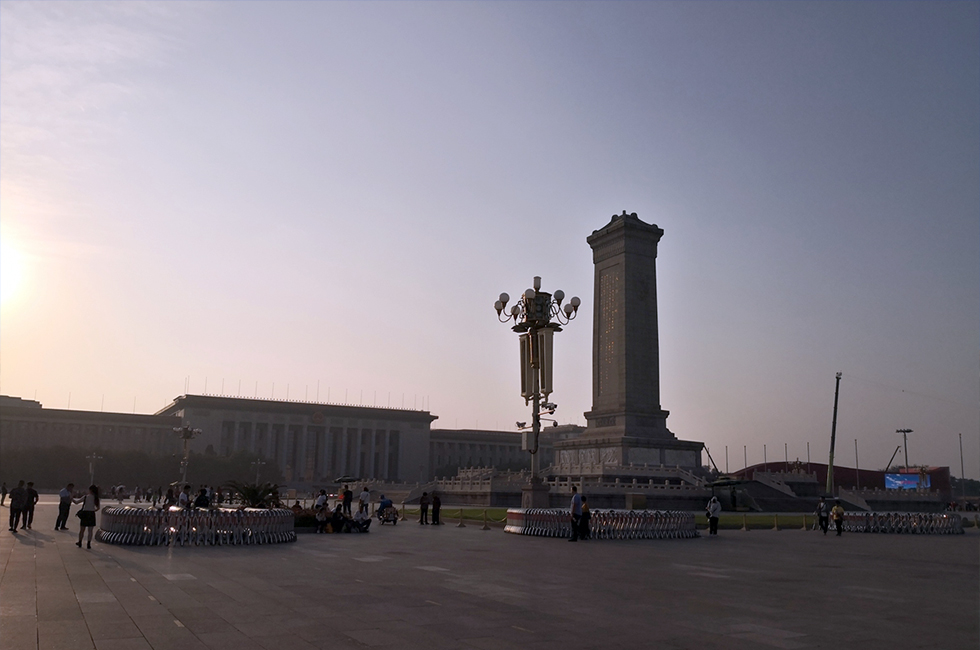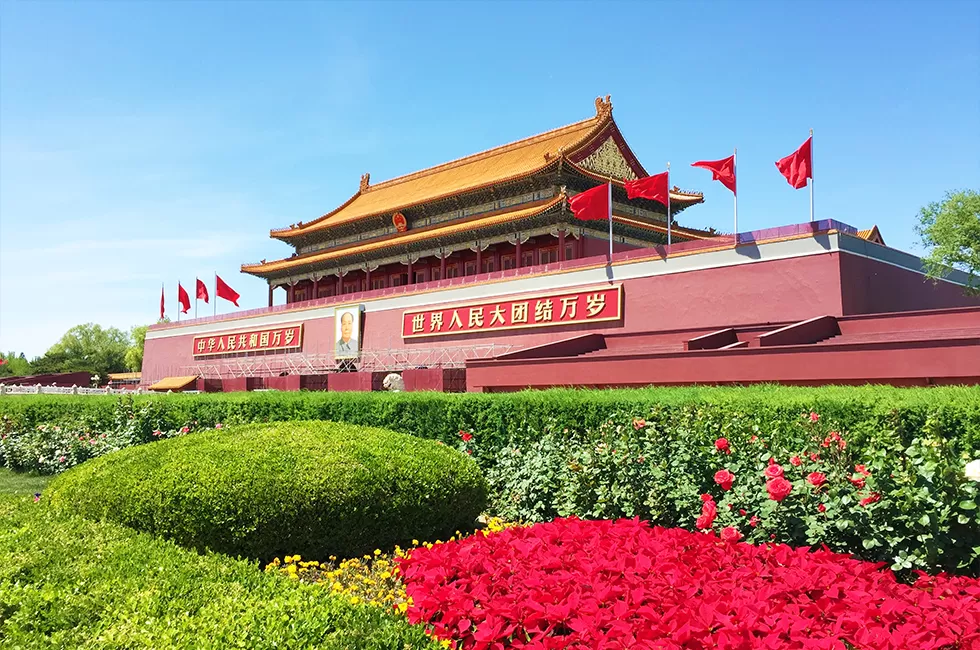Tiananmen Square
Facts
- When to open: no limited
- When to rise the flag: 5am-7am
- What to see: national flag-raising ceremony, Mausoleum of Mao Zedong
- How larg: 440,000 square meters
Brief Introduction
The famous monument “Tiananmen” (which literally means the Gate of Heavenly Peace) is in the center of Beijing, along the northern edge of Tiananmen Square. On October 1st, 1949, the grand ceremony of inaugurating the People’s Republic of China was held here. Thereafter, it has become a symbol of China and featured in the national emblem of China. It symbolizes the bravery and perseverance of the Chinese people in fighting for independence and freedom. It also marks the founding of the People’s Republic of China and its course to a bright future.
The originally named Chengtianmen (the Gate of Accepting Heavenly Succession) was built in 1417. At the end of the Ming Dynasty, it was seriously damaged by war. When it was rebuilt during the Qing Dynasty in 1651, it was renamed Tiananmen, and served as the main entrance to the Forbidden City.
 National flag-raising ceremony
National flag-raising ceremonyTiananmen is 37.4 meters high and 66 meters long. The tower at the top of the gate is nine rooms wide and five deep. According to the Book of Changes, the two numbers 9 and 5, when combined, symbolize the supreme status of a sovereign. There are two lions squatting and also two stone columns standing in front of the gate. The portrait of Mao Zedong was hung above the central gate. On both sides of the portrait, there are two huge eye-catching slogans. On the left side, it reads “Zhong Hua Ren Min Gong He Guo Wan Sui” which means “long live the People's Republic of China”. On the right side, it reads “Shi Jie Ren Min Da Tuan Jie” which means “long live the Great Unity of the World’s Peoples”.
Situated in the south of Tiananmen, the Tiananmen Square takes up an area of 440,000 square meters and can accommodate as many as 1 million people for public gatherings. It stretches 880 meters north to south and 500 meters east to west. It is the largest urban open square in the world. Its figure of solemnity is mainly featured in China’s national emblem.
Built in 1417, during the Ming Dynasty, it was originally named “Chengtianmen”. In 1651, it was renamed “Tiananmen” (Gate of Heavenly Peace) after being restored. Tiananmen Square has witnessed many historical events in China’s modern history, such as the May Fourth Movement in 1919, December 9th Movement in 1935, and the founding of the People’s Republic of China in 1949 and other great ceremonies. It is now a place for celebrations on such festive days as National Day on October 1st and Labor Day on May 1st. There are several famous buildings in Tiananmen Square.
The Great Hall of the People
 The Great Hall of the People
The Great Hall of the PeopleBuilt in 1959, the Great Hall of the People is one of the largest congressional buildings in the world. It stands at the western edge of Tiananmen Square. The Hall is used by the People’s Republic of China and the Communist Party of China for legislative and ceremonial activities such as the holding of NPC (National People’s Congress) and CPPCC (Chinese People’s Political Consultative Conference). There are a number of Great Halls including a 10,000-seat auditorium in the center, a giant banqueting hall in the north facing Chang’an Street, and 5000 offices for the Standing Committee of the National Peoples’ Congress of China in the south. In addition, thirty-four reception chambers are named after various provinces, autonomous regions and municipalities directly under the Central Government, plus Hong Kong SAR and Macao SAR. Each is different from the other in terms of decoration and furnishing, representing the local characteristics respectively.
The Monument to the People's Heroes
 The Monument to the People's Heroes
The Monument to the People's HeroesThe Monument to People’s Heroes is the national monument of the People’s Republic of China. On the southern edge of Tiananmen Square, it was built between 1952 ando 1958 in memory of thousands of martyrs who died for the revolutionary cause of the Chinese people. There is an inscription of Mao Zedong's handwriting on the front of the monument, which reads “Eternal glory to people’s heroes”. In the form of an obelisk, the monument is made of more than 17,000 pieces of granite and white marble. It is 37.94 meters high, 50.44 meters wide east to west, and 61.54 meters long south to north. It is not merely a historic memorial for the heroes, but also it is an artistic work with excellent architectural value.
Mausoleum of Chairman Mao
 Mausoleum of Chairman Mao
Mausoleum of Chairman MaoThe Mausoleum of Chairman Mao is the final resting place of Chairman Mao Zedong, the founder of the People’s Republic of China, who passed away on September 9, 1976. In commemoration of this great man, a mausoleum was constructed in the middle of Tiananmen Square right after his death and was completed in August 1977. The Mausoleum was officially opened on September 9, 1977. The embalmed body of Chairman Mao is displayed in a crystal coffin in the hall for people to pay tribute to him.
There are also exhibitions commemorating the revolutionary deeds done by Zhou Enlai, Deng Xiaoping, Chen Yun and others, which were added in 2001 to mark the 80th anniversary of the foundation of the Communist Party of China.
National Museum of China
 National Museum of China
National Museum of ChinaThe National Museum of China lies in the eastern edge of Tiananmen Square. It consists of two large museums: the Museum of the Chinese Revolution in the north and the National Museum of Chinese History in the south. These two museums were built in 1959. The Museum of Chinese History represents the entire process of Chinese history from 1.7 million years ago to the end of Qing Dynasty. It is divided into three periods: Primitive Society, Slavery Society, and Feudal Society. The Museum of the Chinese Revolution shows the period of the history of the Republic of China to the founding of the People’s Republic of China and subsequent development.
The National Museum of China contains more than 620,385 cultural and historic exhibits and displays many precious and rare Chinese artifacts that cannot be found in any other museum in China or in the world.
GREAT FAMILY CHINA TOUR
JULY 2024 We wanted to thank Grace at China Culture tour for organizing a great tour of China. We enjoyed our Beijing - Xian-Chengdu -Guilin -Yangshuo - Shanghai trip. Our local guides Bruce in Beijing, Susan in Xian, Jane in Chengdu, Mike in Guilin and Mary in Shanghai took care of us…read more details »
Teng Han L from SINGAPORE
Ready to Create a Unique Dream Travel?

